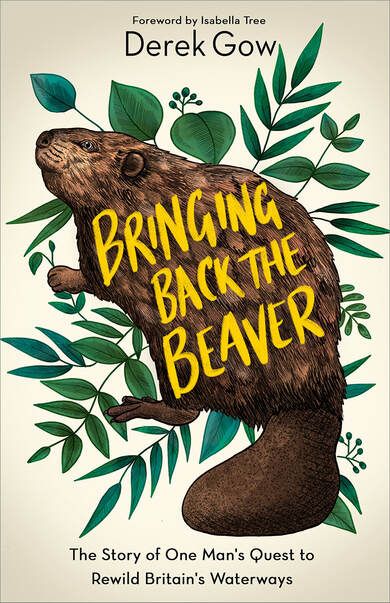
Bringing Back the Beaver, the story of one man's quest to rewild Britain's waterways.
Of all the animals that roamed these isles but have now disappeared many think that the beaver is the most important one to bring back. Like us, beavers are ecosystem engineers, modifying their habitats to suit themselves

Published by Chealsea Green, 2020
Unlike much of what we do (or at least have done recently) the beaver's engineering seems to be of great benefit to other species. Their tree-felling allows in light, creating wetlands and pools where other creatures, from dragon flies to kingfishers, to water voles, can thrive. Without beavers wetlands become shaded by trees and eventually dry out. We can try to mimic beavers by coppicing trees (the regrowth you get after felling of most of our native trees shows that they are adapted to living with beavers) and (in vogue recently) constructing ‘leaky dams’ that ‘slow the flow’. But all this requires a lot of work on our part and beavers are much better at it, so would it not be better just to bring them back?
This is certainly Derek Gow’s view. He has a practical background in conservation and in looking after captive wild animals. This book is part his life story and part history of our relationship with beavers and the long saga of attempts over the past few decades to reintroduce them in England and Scotland. Gow is a larger than life character, forthright in his views and an entertaining speaker. This comes across in his book. For example, in explaining what ‘improved’ means when applied to fenland that is now used for farming he says:
“Improved means quite simply that you smash, poison or reshape marginal land to serve a production goal for which it is generally ill suited. Then you insert the drains, apply herbicides or chemical fertilisers and receive vast grants for eviscerating habitats that possibly date back in time to the Bronze Age and replace them with lifeless monocultures of Italian ryegrass. While this process generally delivers little in terms of produce, intricate communities of fragile wildflowers, herbs, insects, fungi, birds and other small creatures are destroyed on a staggering scale...” (p.80)
While the public are generally supportive of the idea of reintroducing beavers the powers that be in the countryside - landowners, anglers, farmers – are often opposed. In discussing the reaction to Scottish Natural Heritage’s 1994 plan to reintroduce beavers Gow says that public views were dismissed by these powers that be as being those of “‘townies’ who understood nothing. Although it was ‘townies’ taxes that underwrote their lifestyles” (p.4). Gow has harsh words for Scottish landowners who oppose beaver introductions, regarding their views as mostly based on ignorance and stupidity. He describes failed attempts to introduce beavers in South West England to help prevent flooding that were derailed by a few individuals spreading lies and misinformation (p.127). However he reserves his greatest ire for the officials and politicians who have listened to the baseless arguments of those opposing reintroductions. He says:
“I have watched petty individuals in positions of power, who could have helped had they wished to do so, preen and prance. They are fools. In fools’ costumes seeking respect alone for position. Their bell-bedecked headdresses ring forth quite clearly the emptiness of their minds. As technicians they have responsibility for the duties they fail to discharge. They measure their own progress through ensuring inaction. I have witnessed their stupidities.” (p. 51)
In 2009 Gow took part in a meeting between the opposing sides of beaver reintroduction, hosted by Charlie Burrell of the Knepp Estate (see my review of Wilding, which is about this Estate). At this he realised that some of the concerns of landowners and farmers were valid, such as that if reintroduced beavers were to become protected by law their management would be difficult (p.129). He talks about how problems caused by beavers in Bavaria, an intensively farmed landscape, have been resolved by measures such as electric fencing to protect cropland, drainage systems that beavers could not block and trapping and translocation of beavers for introduction elsewhere (p.100).
In Britain an indictment of the official process for reintroducing beavers is that the two populations that are thriving have not resulted from officially sanctioned releases. Scottish Natural Heritage said in 1994 that it wanted to reintroduce beavers but the site that was eventually chosen, Knapdale on the Kintyre peninsula was, argues Gow, picked to placate interest groups and opponents and does not enable the beaver population to grow. In 2014 there were about the same number of beavers as had been released in 2019 (p.149). In contrast, beaver populations that have appeared, no one knows from where, on the Tay in Scotland and the Otter in Devon, have flourished. The official response to the discovery of both populations was that they should be culled. This was only prevented by public outcries. In Scotland it has now been deemed that the beavers on the Tay can remain and be allowed to spread to other catchments, but that there will be no further reintroductions. When they come into conflict with farmers and other landowners they can be shot rather than trapped and moved elsewhere. Gow contrasts this with the more enlightened approach of Bavaria, a much more intensively used farmed landscape where beavers now live in every major watercourse and are accepted as the ‘new normal’. Gow points out that in the first season of officially licensed killing in Scotland, 2019/20 almost 100 beavers were killed and if this continues Scotland could become ‘the first nation in ‘civilised’ history to both reintroduce and extirpate a beaver population in the shortest possible time’ (p.153).
The beavers on the Otter have, since the publication of this book, also been allowed to stay after the end of a five year trial period. However, rather than allowing the gates to be opened on the many private enclosures in the country where beavers are now living the government has said it is going to consult later this year on the possibility of further reintroductions and that no more releases in the wild will be allowed until the consultation is complete. The environment minister is quoted as saying “We are firmly committed to providing opportunities to reintroduce formerly native species, such as beavers, where the benefits for the environment, people and the economy are clear. But we also understand that there are implications for landowners, and take care to ensure that all potential impacts are carefully considered.” Is this consultation just a ploy for further inaction? The history of governments listening to the fears of landowners does not bode well. Gow’s book reveals the undue influence that landed interests, opposed to the wildness that beavers represent, have had over conversation policy in the UK. It is time that this came to an end.



